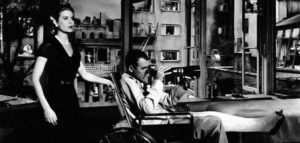To convey suspense and tension in the Night of the Living Dead, George A. Romero arouses expectations and subverts those expectations with uncertainty utilizing editing and sound. Around the 22-minute mark, Barbra surveys the house after a reassuring conversation with Ben. Ben’s consolation is not only received by Barbra within the parameters of the film, but it breaks the fourth wall in consoling the audience—just enough words by Ben to put the audience at ease. As Barbra walks through a doorway, ominous music ramps up and takes away the comfort that Ben initially instills. Barbra fixates her vision towards something, using the music box as the variable for the transition. While the music box plays an innocent melody, a shot of Barbra with the music box out of focus parallels the dispatch to the audience of the focus towards Barbra.
Romero plays with the conjunction of editing and sound to convey to his audience the framework he placates. He juxtaposes the ominous theatrical music with the innocent melody of the music box. Romero constantly puts the audience in a disarray in where he simulates a roller coaster of tension subsequently subverting each other. Visually, Romero fixates on an inanimate object to impart to the audience where the focus should be. He displays Barbra focusing towards the music box and hinges conveying a tone with the object.

Another key editing technique used in this film is the eye-line matching that occurs in the scene of Barbra sitting alone in the room and the strangers crashed into the house. Around 40:14 the direction of Barbra’s eyes moving toward the door determines the direction of screen and the viewers’ perspectives. The eye-line matching shots employed here transfer the eyes of the audience to the things behind the door, enhancing a smooth and continuity from shot to shot and help push the storyline forward.
The sound and music also plays a key role in shaping the whole story and genre of horror. As we see the movie, we noticed that the soundtrack was given not continually. For example, when there involves dialogues between characters, there is not sound or music at background but the real voice of the characters. The sound and music occurs when there are some kind of signal for danger or threats. In 17:00,when Ben is fighting the ghouls around him and Barbra is facing several ghouls inside of the house, the sounds and music are incredibly creepy and thrilling that make the audience feel so nervous. The way of using sound and music helps pave the way for the whole story and create a sense of tension for the audience.
